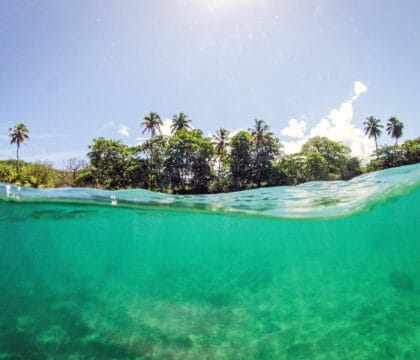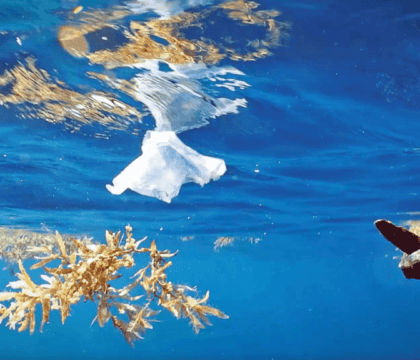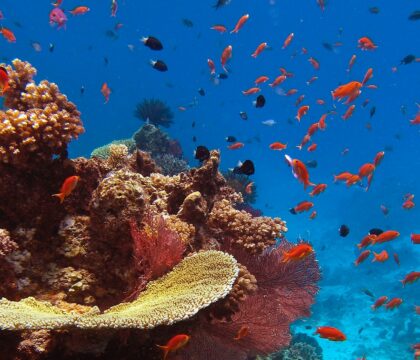April 25, 0204 • Trip Reports
This post was written by Whitney Hansen, a Harvard University undergraduate student who spent two weeks working as an intern at Oceanic Society’s Blackbird Caye Field Station in Turneffe Atoll, Belize in 2014.
Arrival in Belize
I arrived to the Oceanic Society Blackbird Caye Field Station on January 4th after meeting dolphin researcher Eric Ramos, his assistant Megan, and research volunteer Judy at a hotel dock in Belize City, where we boarded a boat headed for the station.
The field station resembles a mini resort, with cabanas on stilts lining the oceanfront, and an elegant palapa sitting in the middle of the area. A dorm building, meant to house staff, researchers, and office space, is behind both the cabanas and palapa. There is a lagoon at the back of the station that is home to many a crocodile (I unfortunately never saw one out of the lagoon), and a pleasant viewing platform was built in front of the lagoon so that guests can try to see them. There is a long dock that stretches out into the little bay where the station is situated, which is where the boats are tied when not active. A short seven-minute walk along a sandy path takes you to the neighboring Blackbird Caye Resort, a 15-bungalow dive operation where I enjoyed several scuba diving opportunities and a trip to the famous Blue Hole.
The Complexities of Studying Dolphin Communications
Our days, for the most part, were easily structured. Three hours in the morning, beginning at 9 A.M., of looking for dolphins and recording sightings with a GPS unit. We would return for lunch at noon, rest until 2pm, and then head back out for another three hours to record additional sightings. Megan, Eric, and I spent significant time building a hydrophone contraption that could be hung over the side of the boat to record dolphin vocalizations underwater. It came close to perfection by the end of my two weeks and, despite structural difficulties, the hydrophones did their jobs.
When Eric began his master’s degree research at Oceanic Society’s field station, asking questions about dolphin acoustics, he recorded dolphins making a thrumming sound that has yet to be recorded anywhere else. There are many similar records of dolphin sounds that are specific to certain isolated populations, such as the population at Turneffe Atoll, and Eric set out to find out what exactly the sound was for. He’s hypothesized that it is a technique the dolphins here use to stir fish out of the sea grass, so the dolphins can more easily hunt them. Now, his study is continuing to try and define what certain sounds mean at Turneffe, what social contexts they are used in, and how universal the sounds are.
From what scientists already know, there exist two sounds that all dolphins use in some form. One is a clicking sound that, when seen on a sound-graph, looks like a bunch of vertical lines lined up next to each other. It is the sound dolphins make when they are using their particular brand of sonar (like the sonar that bats use). We often picked up these sounds on the hydrophones as dolphins tried to use their sonar to understand what the awkward looking hydrophone contraption was. The other type of sounds, the ones Eric is most interested in studying, are whistling sounds. These are social sounds that, on a sound graph, are lines in shapes of little waves, usually ending on a higher pitch than where they began. They are incredibly high pitched and, as of now, we have a limited understanding about what they mean and when they are used. There is also indication that whistling differs between populations of dolphins. When it was storming or we had limited fuel due to no scheduled guests, Eric assigned me to listen to the compilation of hydrophone recordings, listen for whistles, and mark the time in the recording of each whistle. That way we could try to compare the whistles to potential video footage and get the social context.
The extreme difficulty of studying dolphin whistles and their significance is that it’s hard to tell which dolphin is whistling. Unlike the dolphins portrayed in the movie Finding Nemo (as Eric so fondly refers to) that talk with their mouths open, in reality dolphins give no indication that they are making sound since they can make sound through the top of their head. That, and the fact that it’s incredibly hard to track sound underwater, combine to make a difficult obstacle for anyone interested in pursing dolphin acoustics. Eric hoped that by using four hydrophones he’d be able to pinpoint sound location.
After a day’s worth of sighting, either Megan or Eric would give guests (and me) a presentation on dolphin cognitive behavior, acoustic study, or whatever other background information they found relevant for us to know. Megan also graced us with an orca presentation, which I found fascinating.
On stormy days, where we had restricted time (weather allowing) to go out on the boat, I would spend time working on listening to the hydrophones, copying data recorded from previous sightings onto a computer (data recorded involves GPS points of sightings, depth of water, temperature, ocean state, number of dolphins, etc.), editing dolphin identification photos (photos taken of dolphin dorsal fins to identify them as either a previously sighted dolphin or a new one to the area), or being an audience to more presentations.
The dolphin sightings trips around the Atoll were both fascinating and sometimes extremely tiring in the sun, yet they were not the only activity I got to do. Eric was adamant about taking guests out on multiple snorkeling trips at different locations, even though snorkeling right of the dock leads to clear, fish-filled waters. Megan swam with a dolphin one morning just twenty feet from the dock, and I saw maybe ten sting rays myself over the course of the trip. Blackbird Caye Resort offered some excellent scuba diving right off the reef, and the amount of sea life I saw, not just fish, but big fish and sharks and stingrays and barracudas and eels, was incredible.
The Natural Beauty of Turneffe Atoll
The geography of Turneffe Atoll makes it a hotspot for biological diversity. Belize has a reef just off of its coast, and the Atoll lies a few miles further eastward. The Atoll has a beautiful reef off of its eastern shore that essentially drops off into one of the deepest parts of the Caribbean. This means that the environment is rich in nutrients, and therefore fish, with cold minerals sweeping up from the bottom of the Atlantic to settle down on the reef. And since there is nowhere else to go, all the species at the reef have to stay there. In fact, the manatees and dolphins (unless they are open ocean dolphins) mostly swim between mainland Belize and the Atoll, and not far beyond.
All in all, my two weeks in Belize was something I can’t ever forget. I highly recommend this research station as an opportunity for high school to college aged students interesting in pursuing research, to marine biology enthusiasts, or to anyone who enjoys a vacation in a tropical location whilst actively seeking out dolphins. I’m already looking forward to the time I can return, and bring my scuba-loving mother along too.




